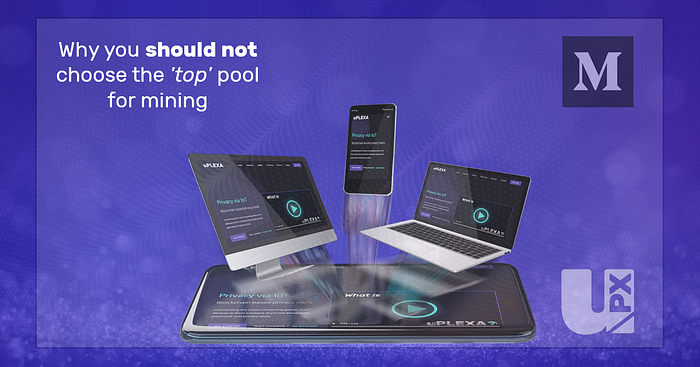
This article is based on a case study provided be a community member on behalf of the uPlexa project.
Decentralization is what every cryptocurrency should thrive for. A decentralized service utilizes devices in a manner of which they do not control. However, users may make the mistake of somewhat centralizing a decentralized service, without the knowledge that they are doing so.
Miners typically have the option to join pools, rather than opt to solo mine. There is this assumption often made by novices in the industry, that the pool with the largest amount of hash power will produce the highest amount of rewards. This can not be farther from the truth.
Theoretically, over time, all pools should provide the same amount of rewards for any particular miner (minus pool fees). However, there are exceptions to this such as geographical distance and latency, among things like poor pool performance and other variables.
What does joining the ‘top’ pool (in terms of hashrate) really do?
Joining the pool with the largest hashrate may cause your favorite project to become.. a somewhat centralized project. With technology these days, PoS/PoW splits, things like 51% attacks are not as much of a concern, but do exist. Not only do you have to trust that the pool owner has no malicious intent, but that it is secure from being hacked in-itself so an attacker does not have the power to hack the pool and then execute an attack against the network. There’s also the problem of downtime, pool outages, etc. which could result in losses for miner, or even worse, weaken the very network that miners are trying to support.
In essence, pools with a more-significant hashrate will provide quicker, more consistent rewards, where as pools with lower hashrate’s will provide less-often but higher rewards. Again, over a time-span, the rewards should end up balancing out (if every pool had the same architecture and infrastructure).
That being said, let’s jump into surfacenoise’s case study regarding uPlexa mining pools, and what the top four pools (in terms of reputation) provide in rewards:
“Last week when uPlexa’s mining difficulty shot up & QuantumLeaper reminded everyone about decentralizing the network hashrate across multiple pools… I decided to point my devices away from HeroMiners and towards MiningOcean instead. I thought… lower pool hashrate but still a significant pool speed (4 MH/s). Great for me, right? Well, I noticed after 24 hours that my block rewards were coming in much slower than HeroMiner (to be expected) but each individual block reward was roughly the same as what I was getting from HeroMiner (weird) and the daily total was significantly lower than when I was getting from HeroMiner’s pool. Strange? I’m a noob! What do I know. But it got me thinking, would my own hashrate provide higher or lower daily reward averages depending on which pool I was mining on?
I’ve been playing around with free credit on VPS services (while learning how to setup and use them… this is all new to me). I got my CPU Rate Limited on Vultr (sorry), so I thought, what if I pointed XMRigCC on 20 of Vultr’s servers at 4 different pools (incl. HeroMiners as a baseline) and counted up the UPX after a few days?
I started Friday night and all 20 servers started mining within an hour of each other. The servers have been working consistently 24/7 (well, one went down for 5 hours but the other 19 held up) and I just shut everything down after nearly 5 days. Each server handled between 240M-260M hashes over nearly 5 days and each 5 server cluster pointed at a pool averaged a total of 2.8kH/s. Each instance is a 1vCPU w/ 1 GIG of RAM (the cheapest service) and ALL the servers were based in Los Angeles.
Here are the results:
#1 — UPXPool (490kH/s Pool Average) — 648 UPX
#2 — Loudmining (401 kH/s Pool Average) — 522 UPX
#3 — HeroMiners (26 MH/s Pool Average) — 483 UPX
#4 — mateV Pool (130 kH/s Pool Average) — 416 UPXWhat does this prove? The only thing conclusive is I’m not going to pay for Vultr after my credit expires.”
— surfacenoise
As we see, the pools with the most amount of technology and support, proved to produce the best results over the one week span. Whilst, the most mined pool came in third for miner rewards. However, it should be noted that all four of these pools should provide the same amount of rewards over a longer period of time (if they’re all using adequate technology, infrastructure, and have the same fees)
Please take this into context when considering which pool to mine to. Remember, as a decentralized currency; it is the communities responsibility to ensure that a network remains decentralized.
Cheers,
QuantumL3aper
PS: Massive shout-out to surfacenoise for taking the time to produce this case study!
